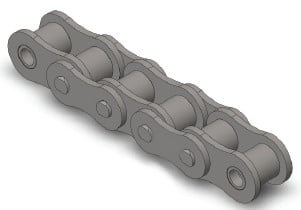Roller chains are a single on the most effective and value eff ective strategies to transmit mechanical energy involving shafts. They operate in excess of a broad array of speeds, deal with large functioning loads, have pretty little power losses and are typically affordable compared with other procedures
of transmitting energy. Productive choice consists of following various relatively basic steps involving algebraic calculation and the use of horsepower and service aspect tables.
For just about any given set of drive conditions, there are a number of achievable chain/sprocket confi gurations that may efficiently operate. The designer consequently must be mindful of a number of fundamental assortment rules that when utilized effectively, enable stability all round drive efficiency and expense. By following the steps outlined within this segment designers really should be ready for making choices that meet the requirements in the drive and are value eff ective.
Basic Roller Chain Drive Rules
? The recommended variety of teeth to the compact sprocket is 15. The minimum is 9 teeth – smoother operation is obtained with far more teeth.
? The proposed highest quantity of teeth for that big sprocket is 120. Note that whilst additional teeth permits for smoother operation acquiring as well a lot of teeth leads to chain jumping off the sprocket soon after a somewhat smaller amount of chain elongation as a consequence of put on – That may be chains having a extremely large quantity of teeth accommodate much less dress in prior to the chain will no longer wrap around them correctly.
? Speed ratios really should be seven:1 or less (optimum) rather than greater
than 10:one. For bigger ratios using multiple chain reductions is suggested.
? The recommended minimum wrap on the smaller sprocket is 120°.
? The proposed center distance among shafts is 30-50 pitches of chain. You will discover two exceptions to this as follows:
one. The center distance must be greater than the sum of your outside diameters with the driver and driven sprockets to stop interference.
2. For velocity ratios greater than 3:one the center distance should not be less than the outdoors diameter of the massive sprocket minus the outdoors diameter from the tiny sprocket to assure a minimal 120° wrap around the  modest sprocket.
modest sprocket.
ASME/ANSI Drive Chain
Tags
